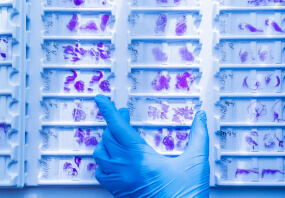Application
This molecular reagent is a polyanionic dye, which is often coupled with the cationic quencher DPX (X1525) for membrane fusion or permeability assays , including complement-mediated immune lysis. The fluorescence of ANTS has been shown to be effectively quenched by Thallium and Cesium ions. Utilized as a neuronal tracer. ANTS has a relatively high Stokes shift in water , which sufficiently separates its emission from the majority of the autofluorescence of biological samples. D2O increased the fluorescence quantum yield of ANTS four-fold, which has been demonstrated to be useful in the determination of water permeability in red blood cell ghosts and kidney collecting tubes . The reducing end of carbohydrates reacts with the primary amino group of the ANTS molecule, forming a Schiff base, which can then be reduced by sodium cyanoborohydride to a secondary amine. This reductive amination reaction is acid catalyzed, so the pH of the reaction solution can alter the kinetics and the degree of derivatization of the carbohydrate by ANTS. It is important to note this reaction is capable of proceeding at a neutral pH, which is favorable for the integrity of the sialic acid bonds in the oligosaccharide because they are sensitive to acid hydrolysis. Such labeling of carbohydrates with ANTS allows for complex mixtures to be separated via capillary electrophoresis .
Fluorescent label for saccharides and glycoproteins used for oligosaccharide sequencing.
- UPC:
- 41116134
- Condition:
- New
- Availability:
- 3-5 Days
- Weight:
- 1.00 Ounces
- HazmatClass:
- No
- MPN:
- 08658-500MG
- CAS:
- 5398-34-5












